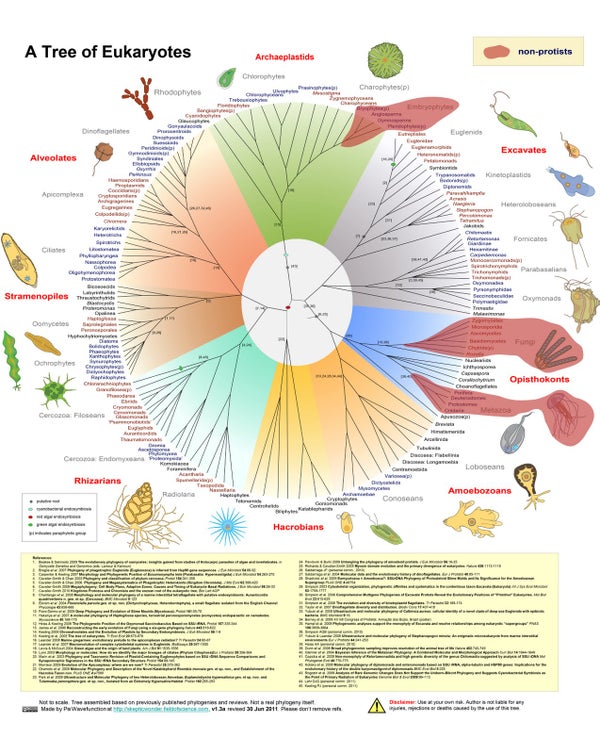This article was published in Scientific American’s former blog network and reflects the views of the author, not necessarily those of Scientific American
We humans are a storytelling species, enamored with our own fantasies and imagination. Throughout all times and places our many cultures have devised fascinating tales of adventures and origins, stretching the limits of our minds — sometimes with the gentle assistance of a little ethnobotany. However, as elaborate and exquisite as our narratives may be, we still cannot compete with those of nearly four billion years of evolution. While far from perfect — in fact, quite slow and inefficient — evolution has had a few orders of magnitude of time on us, and vastly more replicates to fiddle with. Not unlike evolution, human minds cannot conceive concepts out of nothing — new ideas are formed from the alteration and mixing of older ones, with the input of new observations. Even our wildest monsters are, upon closer inspection, usually a mere fusion of extant lifeforms and their parts. We continue to draw inspiration from the natural world around us, even for practical purposes like biomimicry in engineering.
Nearly everyone finds wonder in at least some aspects of natural diversity — whether it lies in the appreciation of exotic plants, the variety of domesticated breeds or simply enjoying a day off from urban chaos. From colorful venomous frogs to fluffy pandas or the strange terror of deep sea fishes, we are all familiar with the iconic images of our biosphere’s diversity. But the greatest biodiversity lies in the unseen, a world so alien yet so pervasive around us. Microbes, not macrobes, comprise the overwhelming majority of the earth’s biosphere, in quantity, mass and variety. While bacterial microbes are quite familiar to the microbiologist and anyone keen on the study of diseases, much less commonly spoken of are the microbial eukaryotes (and related macroscopic offshoots that are neither plant, fungal nor animal) — the protists:
(modified from this Tree of Eukaryotes)
On supporting science journalism
If you're enjoying this article, consider supporting our award-winning journalism by subscribing. By purchasing a subscription you are helping to ensure the future of impactful stories about the discoveries and ideas shaping our world today.
Protists can be found practically anywhere. One is likely familiar with green ‘pond scum’ that blankets pools of stagnant water in the summer months. This was my first introduction to microbial life in my childhood, when a simple microscope revealed an entirely alien world perfectly accessible on earth. Those who live by the sea need not go even that far – the seaweeds lining the ocean shores are themselves protists, having acquired multicellularity entirely independently of animals and land plants. However, most members of the kingdom are microbial, and among them are the more surprising forms. One of the strangest among them is a single-celled alga bearing a complex camera eye, complete with analogues of a lens, an iris and a retinoid. This structure is called the ocelloid. It is not clear how the organism uses the potential image from this contraption, for it has neither a brain nor any neural system at all. Imagine being able to see the world through its eyes, a world in microns, dominated by a different set of physical principles!
While we cannot even obtain this wonderful creature in culture, we can at least fantasize about its life and that of its brethren. Our fantasies shall remain rooted in the observed reality as much as possible, since it is too easy to lose footing and get lost in a realm so different from ours. That said, there is plenty of room for imagination and somewhat aimless recreational hypothesizing, so from time to time I intend to include some sketches (doodles like some here) and stories.
Closely looming over the appreciation of life’s diversity lies the question of how it came to be – in other words, evolution. In addition to exploring the variety of ways protists can be expressed and how they ‘work’, I am interested in general evolutionary mechanisms. After a while, simply looking is no longer enough. While most are at least somewhat familiar with the mechanisms of adaptation and selection in evolution (often synonimised with the term, albeit quite erroneously), there are other crucial mechanisms involved, such as drift and mutational bias. Those topics tend to be excluded from popular literature, perhaps due to their traditionally technical approach. I think a scientific approach to evolution does have its place in popular science, and hope to bring some of it to light in a hopefully somewhat accessible form.
Now, about the macrobe in question: I am currently finishing up my undergraduate at the University of British Columbia and will stay at the bench during my year off before grad school. I have been blogging about protists and evolution at Skeptic Wonder, where I will continue blogging but in a more technical and loosely organised manner. I can be found and poked on Twitter via @PsiWavefunction; and reached by email at psi.wavefunction [at] gmail{dot}com. I am also a moderator on the microscopy subreddit, a community for sharing micrographs and discussing our adventures in the world of the small. Questions about identification are particularly welcome there, so come along and join us!
My past writing at Skeptic Wonder has focused largely on protists, perhaps unsurprisingly — posts have included things like the complex armoured cell surface structure of cryptomonads and specialised plastid-thieving ciliates. Bouts of procrastination with a microscope have yielded piles of pictures and videos of glimpses at microbial life presented as “Microforays“. Broader topics include a few posts on non-adaptive evolution: including an overview of Constructive Neutral Evolution and an attempted explanation of a recent paper on protein complexity evolution. Occasionally I do warily peek outside the protist kingdom, which has led to posts on other strange creatures like social onychophorans and extremely salty square archaeans.
